Options are financial derivatives that provide traders with the right, but not the obligation, to buy (call option) or sell (put option) an underlying asset at a predetermined price (strike price) within a specified time frame (expiration date) in exchange for a premium payment. They are versatile trading instruments that can be based on various underlying assets, including stocks, indexes, commodities, currencies, crypto and more. Options allow traders to profit from price movements in the underlying asset without needing to own the asset itself. This characteristic makes options a popular choice for speculators and hedgers in the financial markets.
Options trading can be quite complex, leading to several common confusions and misunderstandings among those new to the world of financial derivatives. One prevalent misconception is that buying options is a surefire way to make money. Some beginners assume that purchasing call options (betting on a rise in the underlying asset’s price) or put options (betting on a fall in the underlying asset’s price) guarantees profits. However, this is far from the truth. Options come with premiums that traders must pay upfront, and if the anticipated price movement doesn’t occur within the specified timeframe, those premiums can be lost entirely. Options trading involves inherent risks, and there are no guaranteed profits.
Another common misunderstanding is related to the concept of leverage in options trading. While leverage can magnify potential returns, it also amplifies potential losses. Some individuals might underestimate the risks associated with options due to the ability to control a large underlying asset position with a relatively small amount of capital. This misconception can lead to significant financial losses if traders don’t fully grasp the mechanics and potential downsides of leverage in options. It’s crucial for traders to approach options trading with a clear understanding of the risks involved, employ proper risk management strategies, and continually educate themselves to mitigate these common misconceptions.
One of the key advantages of trading options, especially for traders with limited capital, is the leverage they offer. Options enable traders to control a significant amount of the underlying asset with a relatively small amount of capital. This is achieved through the use of option premiums, which are the prices paid to purchase options. Options typically cost only a fraction of the price of the underlying asset, known as the premium. Because of this, traders can employ strategies like buying call options to profit from rising prices or buying put options to profit from falling prices, all while risking only the premium paid. This leverage can amplify potential returns, but it also comes with increased risk, as losses can be substantial if the market moves against the trader. It’s important for traders to fully understand options and the associated risks before engaging in options trading, especially when using leverage to control larger asset positions.
The diagram below will help explain the 4 primary and basic options positions. The following graphic views each in isolation and simply focuses on the desired price directionality for the option to be profitable. As long as you are buying a call or buying a put you have rights. But once you step into the second column of selling (creating) a call option or selling a put option for the options contract has obligations that need to be fulfilled if the options the buyer demands.
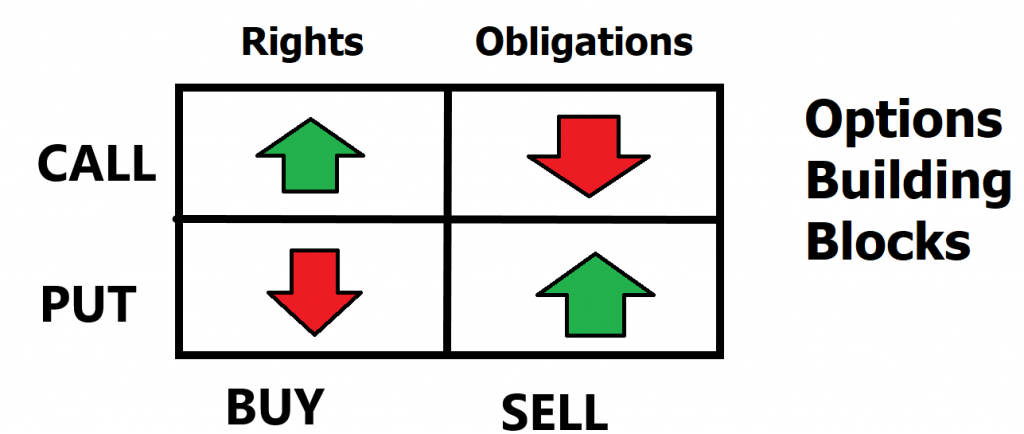
In order to grasp the essence of what an option truly represents, it’s essential to draw a clear distinction between a “right” and an “obligation.” When you acquire an option, you’re essentially purchasing a right. This implies that as a buyer, you’re paying out a premium to the option’s creator for the privilege of having the “right” to buy an asset at a specified price within a defined time frame. This foundational definition underscores the critical characteristics shared by all options: they’re derivative contractual agreements with a finite lifespan, and the buyer is under no obligation to take action—rather, they possess a right.
An easy way to wrap your head around this concept is to think about any insurance policy you may have owned. An insurance policy is, at its core, an options contract. As the policyholder, you’re endowed with the right to a particular degree of protection within a certain time frame. In exchange for this right, you’re shelling out a premium to the insurance company, essentially paying for that coverage. Much like options, your insurance policy carries an expiration date, beyond which you’re left unprotected unless you choose to renew the policy and pay another premium.
Now, it’s worth noting that all options share these identical characteristics. Take the Call Option, for instance. It grants the buyer the right—notice the emphasis on “right”—but not the obligation to own the underlying asset from the present moment until the expiration date, all in exchange for a premium. What’s intriguing here is that as the buyer of the option, you theoretically possess unlimited profit potential. This potential knows no bounds because, in theory, the stock can climb to astronomical heights.
Moreover, each option contract in the stock market exerts control over a neat and tidy 100 shares. But that’s not all—options also have a predetermined price, known as the strike price. This price is the agreed-upon level at which you’re entitled to exercise your right to own the underlying asset, yet you’re still not obligated to do so. And let’s not forget that each option comes with its own expiration date, indicating the contract’s duration. These durations can vary, with most options available in 30-, 60-, and 90-day increments. However, you’ll also come across LEAPS (Long-Term Equity Anticipation Securities), which are long-term options spanning a year or more.
The bottom line? Every option comes equipped with a premium amount, serving as the cost of entry into the world of buying or selling options. For buyers, this premium represents the price tag for controlling 100 shares of the underlying asset, all the way up until that expiration date comes knocking.
The arch enemy of an option buyer is time. Since options are only good for a finite period of time the key to having success in options trading is being able to determine whether the expectations of volatility in the asset are increasing or decreasing. Since options are time sensitive instruments their price will increase exponentially when volatility is increasing. Likewise, an options price will decrease rapidly when volatility is decreasing.
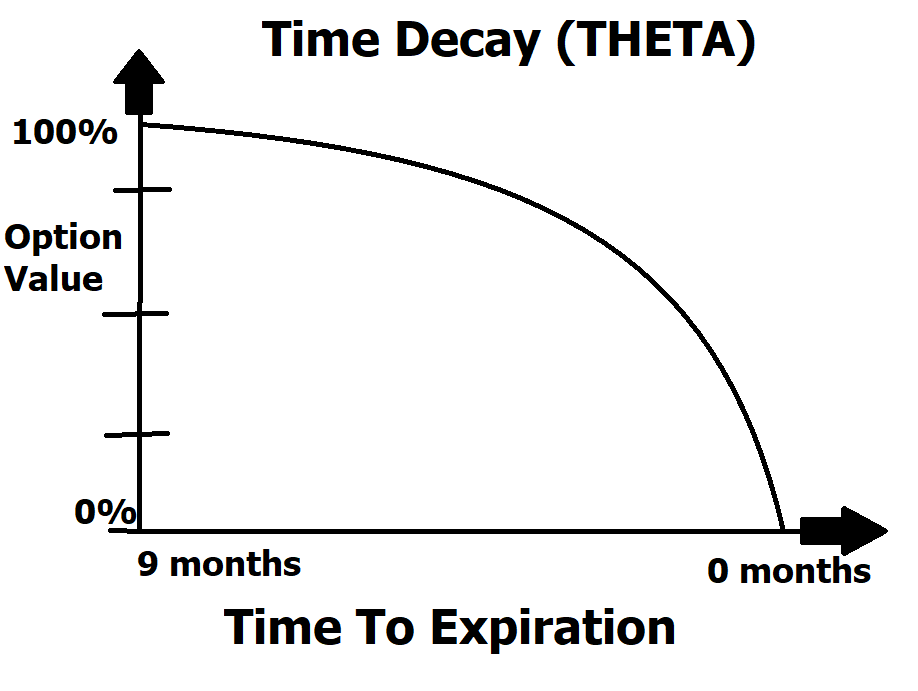
Implied volatility (IV) is a crucial concept in options trading that reflects the market’s expectations about the future price fluctuations of an underlying asset. It is a critical component in pricing options, as it directly affects the premium (price) of an option contract. Implied volatility represents the market’s consensus on the level of uncertainty or risk associated with the underlying asset’s future price movements.
– Implied volatility is a forward-looking concept, unlike historical volatility, which is based on past price movements.
– It is expressed as a percentage and reflects the annualized expected price range of the underlying asset.
– High implied volatility suggests a higher expected range of price movement, while low implied volatility indicates a narrower expected range.
– The Volatility Index, or VIX, is a well-known measure of implied volatility for the S&P 500 index options and serves as a market sentiment indicator.
– Implied volatility can help traders gauge the market’s expectations regarding an asset’s price movement. A sudden spike in implied volatility may indicate an impending event, such as earnings reports or geopolitical news.
– High implied volatility results in higher option premiums, making selling options more attractive for income generation (e.g., covered calls, cash-secured puts).
– Low IV Strategies: In periods of low implied volatility, traders may prefer strategies like buying options (long calls or long puts) because the cost of premiums is relatively lower.
– High IV Strategies: During high implied volatility, traders may opt for strategies that involve selling options (credit spreads, iron condors) to capitalize on elevated premiums.
It’s important to note that implied volatility is just one factor to consider when developing an options trading strategy. Traders should also take into account other factors like time decay (theta), underlying asset fundamentals, and technical analysis when making trading decisions. Additionally, traders should be aware that implied volatility can change rapidly, so staying informed and adjusting strategies accordingly is crucial for success in options trading.
Here is a graph of the Volatility Index over the past year. There are a couple of important aspects that traders must evaluate when using the $VIX as a trading tool.
Many traders look at the $VIX similarly to any 52-week chart to develop an understanding of what has been considered high and what has been considered low. The chart below is for the past 52 weeks. The horizontal line is the value of 20. Anything above 20 is considered bearish for stocks. You can quickly see how often this occurred over the past year.
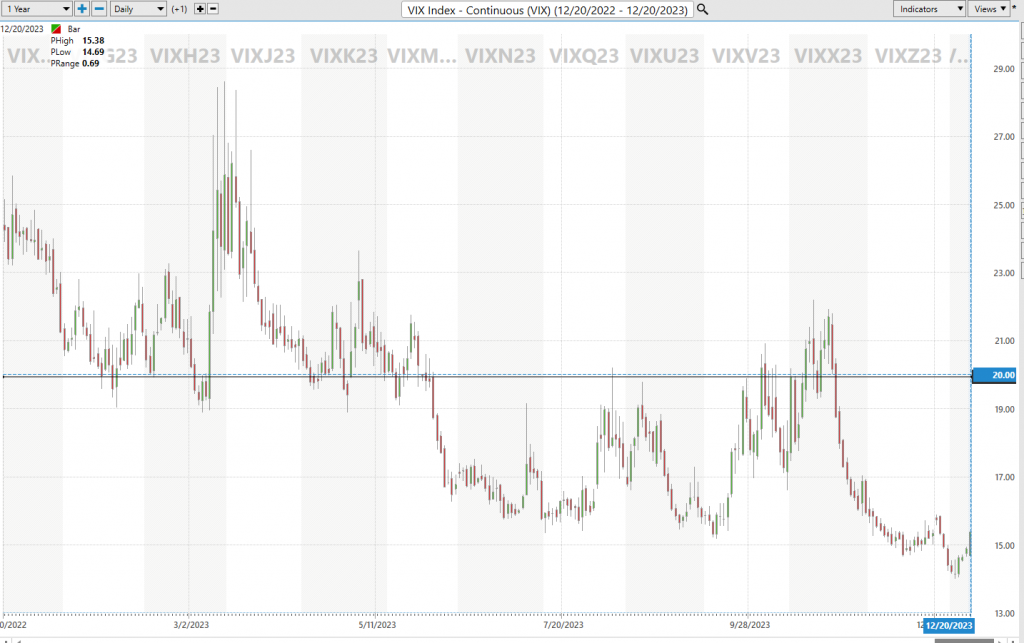
In the world of options trading, mastering the $VIX, or CBOE Volatility Index, can be the key to unlocking potential profits and managing risk. Often referred to as the “fear gauge” or “fear index,” the $VIX is a powerful indicator that reflects market expectations of near-term volatility in the stock market.
The $VIX is a numerical representation of market volatility expectations over the next 30 days. It is derived from the prices of a specific set of S&P 500 index options with varying expiration dates. The core idea behind the $VIX is that when investors anticipate significant market volatility, they tend to pay more for options as a hedge against potential losses or to profit from market swings.
**High vs. Low Values**: A high $VIX value, typically above 20, suggests that investors expect significant price swings in the stock market, indicating fear or uncertainty. In contrast, a low $VIX value, usually below 20, indicates anticipated market stability, reflecting confidence or complacency.
– **Historical Context**: Understanding the historical range of the $VIX provides insights into whether the current level is relatively high or low. Extreme values often signal potential market turning points.
The $VIX is more than just a numerical index; it reflects the collective sentiment of market participants. When traders are worried about potential market downturns, the $VIX tends to spike, and when they feel more secure, the $VIX drops. As such, it serves as a valuable barometer of market psychology, offering clues about the broader market trend.
The $VIX is inversely correlated with stock indices like the S&P 500. This means that when the stock market is experiencing high volatility and stock prices are falling, the $VIX tends to rise. Conversely, when stock indices are in an uptrend and experiencing relatively low volatility, the $VIX tends to be low.
Below is a 52-week chart of the S&P 500 Index and the $VIX. Observe how they move in opposite directions.
This inverse correlation exists because the $VIX is calculated based on the implied volatility of S&P 500 options. When investors become more concerned about potential price declines (higher volatility), they tend to buy put options on the S&P 500, driving up option premiums and, subsequently, the $VIX.
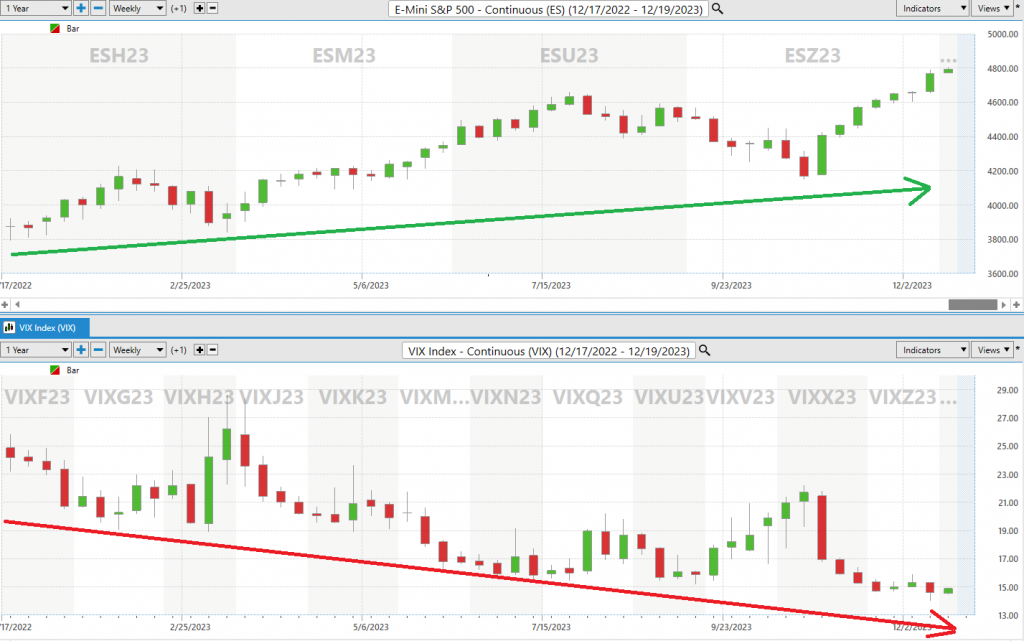
Implied volatility is a critical component in options pricing. It represents the market’s expectations of future price fluctuations. When implied volatility is high, options premiums tend to be higher, making options more expensive.
Why should options traders pay attention to the $VIX? Here’s why:
The $VIX primarily influences options pricing through implied volatility. When the $VIX is high, options premiums are generally elevated. Traders are willing to pay more for options to protect their portfolios or speculate on significant market moves. Conversely, when the $VIX is low, options premiums tend to be lower.
One of the most significant benefits of monitoring the $VIX is its ability to provide insights into market direction:
**High $VIX**: When the $VIX is high, it often signals bearish sentiment and the potential for market downturns. In this scenario, options traders may consider positioning themselves with put options, which allow them to profit from falling prices or hedge against losses.
**Low $VIX**: A low $VIX often indicates bullish sentiment and expectations of market stability or even an upward trend. Traders may consider positioning themselves with call options, which provide the opportunity for gains if the underlying asset’s price rises.
In periods of high market volatility (high $VIX), options traders might consider the following strategies:
**Buying Protective Puts**: This strategy involves purchasing put options to hedge against potential losses in an existing stock position.
**Selling Covered Calls**: Traders who own the underlying stock can sell covered call options to generate income while potentially capping their upside profit potential.
In periods of low market volatility (low $VIX), options traders may explore these strategies:
**Buying Calls**: This strategy allows traders to profit from potential price increases in the underlying asset while risking only the premium paid for the call options.
**Selling Cash-Secured Puts**: Selling put options with cash on hand to cover the potential purchase of the underlying asset if the options are exercised. This strategy generates income and allows traders to acquire the asset at a discount.
To illustrate the concepts discussed in this article, let’s explore these ideas using the VantagePoint artificial intelligence software and Neural Index by applying those specific indicators to the $VIX chart. These real-world scenarios will help you better understand the practical application of $VIX analysis and how it communicates market sentiment and trend direction.
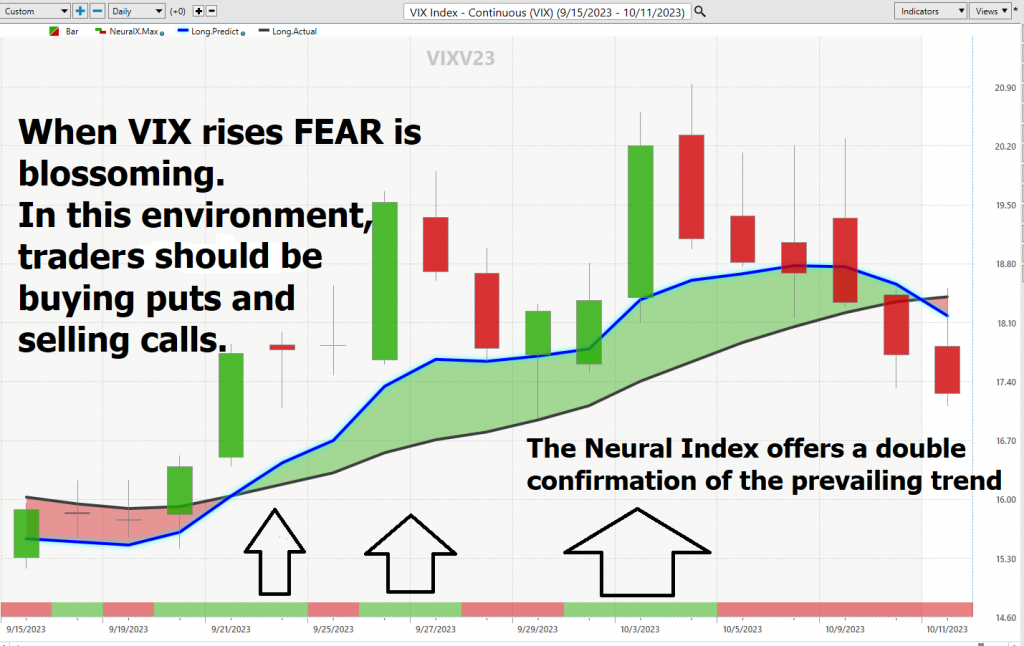
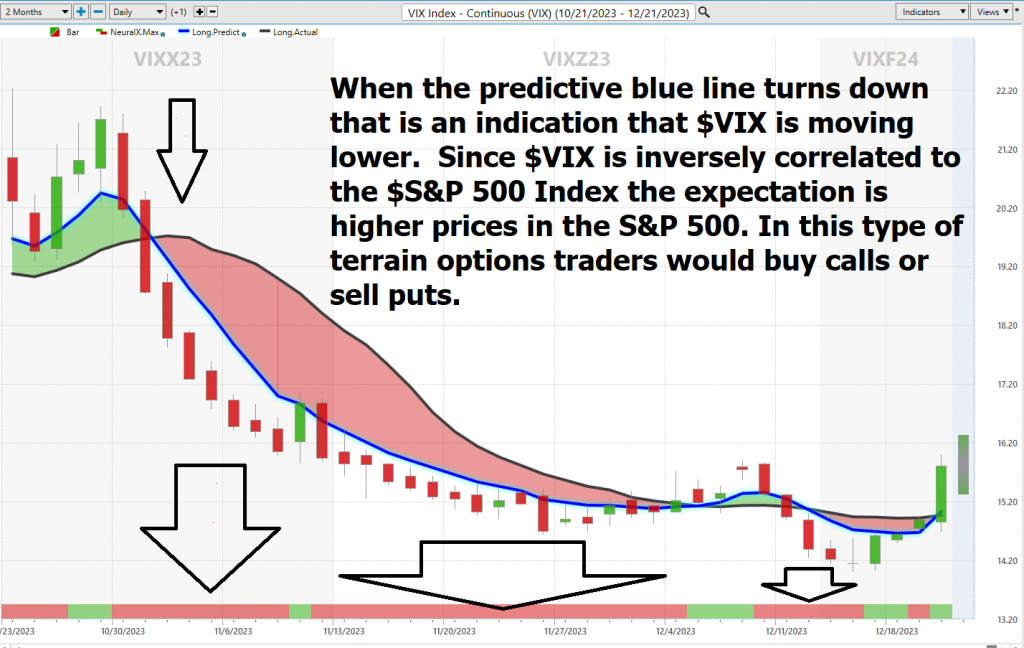
The $VIX is a powerful tool for options traders, offering insights into market sentiment, options pricing, and potential trading strategies. By mastering the $VIX and using it as a barometer of market trends, traders can make informed decisions about when and how to position themselves in call and put options. However, it’s crucial to remember that options trading involves risk, and proper risk management is essential to long-term success. Incorporate $VIX analysis using the VantagePoint AI analysis into your trading toolbox and continue to educate yourself to navigate the dynamic world of options trading with confidence.
In summary, the $VIX is a valuable tool for traders and investors to gauge market sentiment, especially when used as a trend indicator and in conjunction with other market analysis techniques. Its inverse correlation with stock indices makes it a useful gauge of market fear and volatility, helping traders navigate various market conditions. Start your analysis of your options trading with a thorough analysis of the $VIX. Doing so will eliminate a ton of rookie options trading mistakes.
To succeed with options trading it is essential that you are on the right side of the $VIX trend at all times. Otherwise, you are inviting massive drawdowns to your trading portfolio.
Intrigued? We discuss and explore these concepts and ideas in our Free Online Learn To Trade With Artificial Intelligence Master Class. Register Here.
This is how Vantagepoint artificial intelligence simplifies and empowers traders daily!
Discover why artificial intelligence is the solution professional traders go to for less risk, more rewards, and peace of mind.
Make it count.
It’s Not Magic.
It’s Machine Learning.
THERE IS A SUBSTANTIAL RISK OF LOSS ASSOCIATED WITH TRADING. ONLY RISK CAPITAL SHOULD BE USED TO TRADE. TRADING STOCKS, FUTURES, OPTIONS, FOREX, AND ETFs IS NOT SUITABLE FOR EVERYONE.IMPORTANT NOTICE!
DISCLAIMER: STOCKS, FUTURES, OPTIONS, ETFs AND CURRENCY TRADING ALL HAVE LARGE POTENTIAL REWARDS, BUT THEY ALSO HAVE LARGE POTENTIAL RISK. YOU MUST BE AWARE OF THE RISKS AND BE WILLING TO ACCEPT THEM IN ORDER TO INVEST IN THESE MARKETS. DON’T TRADE WITH MONEY YOU CAN’T AFFORD TO LOSE. THIS ARTICLE AND WEBSITE IS NEITHER A SOLICITATION NOR AN OFFER TO BUY/SELL FUTURES, OPTIONS, STOCKS, OR CURRENCIES. NO REPRESENTATION IS BEING MADE THAT ANY ACCOUNT WILL OR IS LIKELY TO ACHIEVE PROFITS OR LOSSES SIMILAR TO THOSE DISCUSSED ON THIS ARTICLE OR WEBSITE. THE PAST PERFORMANCE OF ANY TRADING SYSTEM OR METHODOLOGY IS NOT NECESSARILY INDICATIVE OF FUTURE RESULTS. CFTC RULE 4.41 – HYPOTHETICAL OR SIMULATED PERFORMANCE RESULTS HAVE CERTAIN LIMITATIONS. UNLIKE AN ACTUAL PERFORMANCE RECORD, SIMULATED RESULTS DO NOT REPRESENT ACTUAL TRADING. ALSO, SINCE THE TRADES HAVE NOT BEEN EXECUTED, THE RESULTS MAY HAVE UNDER-OR-OVER COMPENSATED FOR THE IMPACT, IF ANY, OF CERTAIN MARKET FACTORS, SUCH AS LACK OF LIQUIDITY. SIMULATED TRADING PROGRAMS IN GENERAL ARE ALSO SUBJECT TO THE FACT THAT THEY ARE DESIGNED WITH THE BENEFIT OF HINDSIGHT. NO REPRESENTATION IS BEING MADE THAT ANY ACCOUNT WILL OR IS LIKELY TO ACHIEVE PROFIT OR LOSSES SIMILAR TO THOSE SHOWN.






